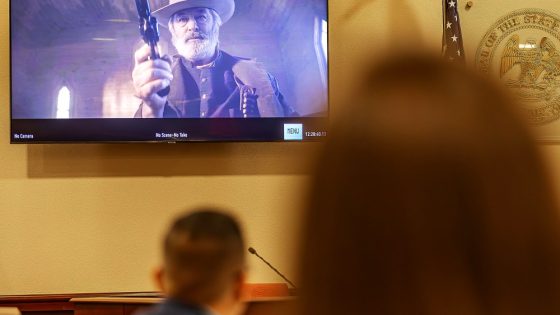Since shortly after the fatal shooting on the set of “Rust,” Alec Baldwin has been adamant that he did not pull the trigger.
That claim has been a key element of Baldwin’s public defense and a way for him to disclaim all responsibility for the death of cinematographer Halyna Hutchins. Prosecutors find the claim “absurd on its face” and have gone to great lengths to disprove it.
But in his opening statement on Wednesday, defense attorney Alex Spiro acknowledged, for the first time, that Baldwin may be wrong, and that he may have pulled the trigger. He argued that would still not make him criminally negligent.
“On a movie set, you’re allowed to pull the trigger,” Spiro said. “Even if he intentionally pulled the trigger… that doesn’t make him guilty of homicide.”
The prosecution intends to spend much of the manslaughter trial proving that Baldwin did pull the trigger. In her opening statement, special prosecutor Erlinda Johnson said that numerous firearms experts will testify that the gun was working properly at the time of the shooting. The prosecution will go so far as to bring in manufacturer Alessandro Pietta from Italy to tell jurors about his quality control measures.
“The evidence will show… this gun functioned and worked just fine,” Johnson said.
The prosecution is also expected to call at least one member of the crew to testify that he saw Baldwin pull the trigger.
The defense has not conceded the point entirely. Baldwin’s lawyers still plan to argue that it’s possible the gun may have misfired. They will argue that an FBI examiner needlessly destroyed the gun, making it impossible to know with certainty that it was functioning normally.
Spiro also argued that the gun has a “hair trigger” and that the owner’s manual states that the gun can accidentally go off if the hammer is dropped on a live primer.
But Spiro also tacitly acknowledged that jurors may ultimately conclude that Baldwin did pull the trigger. He urged them to acquit him anyway.
“If he did, of course, that would only make his statement incorrect,” Spiro said. “That would mean he would have misspoke.”
He called the issue a “shiny object,” meant to distract from the key fact that the gun would have been harmless had it not been loaded with a real bullet — a grave violation of film industry safety standards.
“When this issue discussed, it’s easy to sort of pull yourself into courtroom-land and away from a movie set,” Spiro argued. “He did not know, or have any reason to know, that the gun was loaded with a live bullet. That’s the key. That live bullet is the key. That is the lethal element.”
Spiro argued that investigators were unable to find the source of the live bullet, and so they turned their attention instead to trying to prove that Baldwin’s adamant denial was false.
“If they could prove that he intentionally pulled the trigger, and he was imperfect, imprecise, wrong with what he said, then maybe you take that, and you say that he’s lying,” Spiro said. “And if he’s a liar, he committed homicide… They’re blinded by the shine. They’re blinded by trying to disprove Alec.”
Spiro’s tactical approach is in marked contrast to the defense in the trial of Hannah Gutierrez Reed, the “Rust” armorer who loaded the live round into Baldwin’s gun.
Her lawyer, Jason Bowles, argued in that case that she was a “scapegoat” for mistakes made by others. In both his opening and closing arguments, Bowles focused on the state’s burden to prove its case, and did not concede any potential wrongdoing or fault on Gutierrez Reed’s part. He did not even concede the broadly accepted notion that Gutierrez Reed, then 24 and working as an armorer for just the second time, was inexperienced.
“She was trained, educated, and ready for this job,” Bowles said in his opening statement.
Gutierrez Reed was convicted of involuntary manslaughter in less than three hours. Whether Spiro’s different approach will lead to a different outcome is yet to be seen.
Source Agencies


